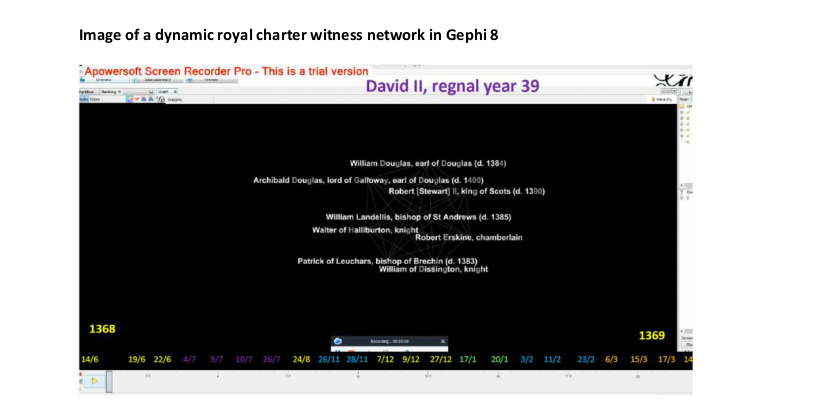Matthew Hammond
Time and Place: Friday, 02.07., 11:30–11:50, Room 1
Session: Data and Methodology
Keywords: longitudinal networks, dynamic graphs; medieval history
In an important article published in 2015 titled ‘Taking time seriously. How do we deal with change in historical networks?’, Claire Lemercier makes a number of cogent points about modelling longitudinal data, starting with the fact that the social sciences model based on sociometric questionnaires is inherently less concerned with change over time in networks than are historians and others studying the past. Lemercier raises a few vital issues regarding the application of social network analysis to historical change. One of these is the problem of identifying ‘chunks of time that substantively capture the nature of relational events’; these decisions should be ‘rooted in historical reflection on the significance of each type of tie for the actors and that they can be reversed and experimented with’. The first order of business should be to ‘make our research questions more explicit, so that they can be translated into ‘tasks’. The nature of the methods we focus on, such as the persistence of ties over time or changes in the size or character of the network, not to mention assigning the appropriate duration of time for each ‘snapshot’ in a dynamic network, should flow from the research question.1
In this paper, I will apply these questions to a sample dataset, a common one in the study of medieval polities, namely the changing attendance at the itinerant king’s court, in this case using data drawn from witness lists of charters of fourteenth-century Scottish kings, extracted from the People of Medieval Scotland database (www.poms.ac.uk).2 Dynamic sociograms have been created in Gephi 8: these are useful but also pose interesting methodological questions about unevenness of evidence and effective visualization of change over time. It is also possible to understand change over time in terms of percentage year-on-year (or snapshot-on-snapshot) variation, both in personnel attendance and in size of network. Structuring the longitudinal ‘snapshots’ to best answer research questions inevitably leads us to ask about the relationship between the individual datasets making up the dynamic graph and event on the ground. In the fourteenth century, documents are dated, allowing us to create datasets based on regnal year or calendar year; in the twelfth century, by contrast, documents were undated, necessitating the creation of longer datasets based on changes in key personnel. While the former state of affairs gives the historian more options, the latter at least was not arbitrary but rather based on intrinsic elements of the network, i.e. change in nodes. Ideally, the historian wants the flexibility to create various types of ‘snapshots’, using whatever arbitrary or historically meaningful data is relevant to their research question. Furthermore, variations in size of networks can also point to qualitative differences in the social events on the ground. In this case, charters issued at parliaments and full councils may be seen in a different light than those issued in the routine order of business. I will present a new methodology that takes all these concerns into account. While this is possible to create in Gephi 8, it is very onerous. Thus, the desirability of bespoke software to better cope with these concerns will be discussed.
1 Claire Lemercier, ‘Taking time seriously. How do we deal with change in historical networks?’, in M. Düring, M. Gamper, and L. Reschke (Hg.), Knoten und Kanten III. Soziale Netzwerkanalyse in Politik- und Geschichtswissenschaft (2015), 183-211, with quotes at pages 12, 15, and 23.
2 Amanda Beam, John Bradley, Dauvit Broun, John Reuben Davies, Matthew Hammond, Neil Jakeman, Michele Pasin and Alice Taylor (with others), People of Medieval Scotland: 1093–1371 (Glasgow and London, 2019), www.poms.ac.uk [accessed 13/02/2020]
